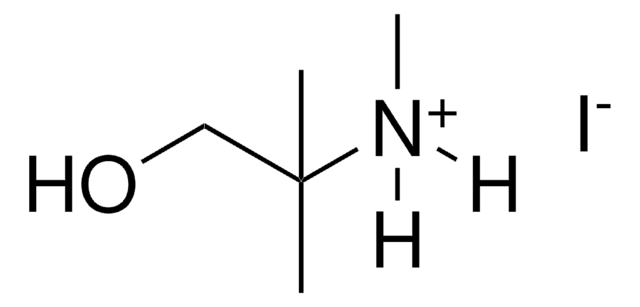推薦產品
品質等級
化驗
99.999% trace metals basis
形狀
solid
反應適用性
reagent type: catalyst
core: lead
雜質
≤15.0 ppm Trace Metal Analysis
bp
954 °C (lit.)
mp
402 °C (lit.)
密度
6.16 g/mL at 25 °C (lit.)
SMILES 字串
I[PbH2]I
InChI
1S/2HI.Pb/h2*1H;/q;;+2/p-2
InChI 密鑰
RQQRAHKHDFPBMC-UHFFFAOYSA-L
尋找類似的產品? 前往 產品比較指南
一般說明
應用
- A precursor salt in the fabrication of perovskite solar cells. The addition of a small molar excess of PbI2 to the precursor solution can enhance device performance by improving charge extraction.
- A potential electrode material in battery configurations due to its electrochemical properties. Its ability to undergo reversible reactions makes it a candidate for use in lead-based batteries.
- A key component in combination with lead monoxide (PbO) to create a stable and sensitive semiconductor detector material for non-destructive testing (NDT) radiation dose detection.
- A key component to develop X-ray detectors for medical imaging.
- To prepare cesium lead iodide perovskite quantum dots for highly stable LEDs.
訊號詞
Danger
危險分類
Acute Tox. 4 Inhalation - Acute Tox. 4 Oral - Aquatic Acute 1 - Aquatic Chronic 1 - Repr. 1A - STOT RE 2
儲存類別代碼
6.1C - Combustible acute toxic Cat.3 / toxic compounds or compounds which causing chronic effects
水污染物質分類(WGK)
WGK 3
閃點(°F)
Not applicable
閃點(°C)
Not applicable
個人防護裝備
Eyeshields, Gloves, type P3 (EN 143) respirator cartridges
分析證明 (COA)
輸入產品批次/批號來搜索 分析證明 (COA)。在產品’s標籤上找到批次和批號,寫有 ‘Lot’或‘Batch’.。
客戶也查看了
文章
Dye-sensitized solar cells as a promising, low-cost photovoltaic technology.
Colloidal quantum dots (CQDs) are semiconducting crystals of only a few nanometers (ca. 2–12 nm) coated with ligand/surfactant molecules to help prevent agglomeration.
膠體量子點 (CQDs) 是只有數奈米 (約 2-12 奈米) 大小的半導體晶體,表面塗有配體/界面活性劑分子,有助於防止聚集。
Controlled synthesis of metal clusters regulates ligands and atoms, advancing metal nanomaterial synthesis.
相關內容
Next generation solar cells have the potential to achieve conversion efficiencies beyond the Shockley-Queisser (S-Q) limit while also significantly lowering production costs.
我們的科學家團隊在所有研究領域都有豐富的經驗,包括生命科學、材料科學、化學合成、色譜、分析等.
聯絡技術服務












